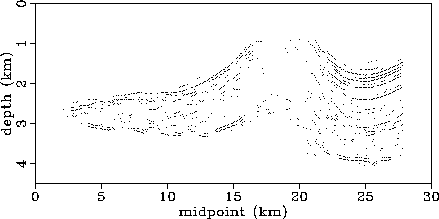 |
Figure 9 The reflector points used in the velocity estimation algorithm. The objective function is obtained by summing the semblance at the appropriate value of
 |
The dips of events in the stacked section are needed for the
computation of ![]() and can be obtained by computing local
dip spectra and picking the maxima.
The velocity information of nearby reflector points with the same
dip is redundant especially when the velocity varies smoothly
laterally.
Selecting a sparse set
of reflector points to use in the computation of
the objective function reduces the cost of the inversion.
The reflector points that were chosen
were locally maxima in dip semblance and had high minimum entropy
norms (Berkhout, 1984) of their dip spectra.
It is especially worthwhile to try to select points sparsely normal
to the dominant dip and enhance continuity along the dip direction.
The picking algorithm penalizes nearby picks in the direction normal
to the dominant dip
and encourages picks that form continuous prominent reflectors.
For the first run of the inversion I also chose not to pick shallow
events.
Figure 9 shows the reflector points that were picked and used for
updating the interval slowness model.
and can be obtained by computing local
dip spectra and picking the maxima.
The velocity information of nearby reflector points with the same
dip is redundant especially when the velocity varies smoothly
laterally.
Selecting a sparse set
of reflector points to use in the computation of
the objective function reduces the cost of the inversion.
The reflector points that were chosen
were locally maxima in dip semblance and had high minimum entropy
norms (Berkhout, 1984) of their dip spectra.
It is especially worthwhile to try to select points sparsely normal
to the dominant dip and enhance continuity along the dip direction.
The picking algorithm penalizes nearby picks in the direction normal
to the dominant dip
and encourages picks that form continuous prominent reflectors.
For the first run of the inversion I also chose not to pick shallow
events.
Figure 9 shows the reflector points that were picked and used for
updating the interval slowness model.